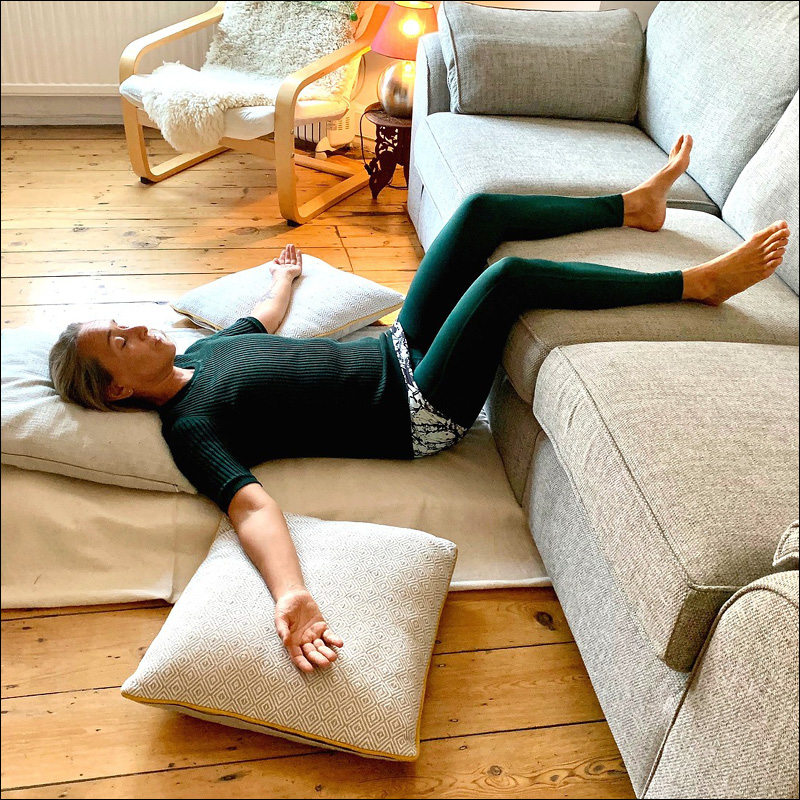
26 Oct GUEST POST: RESTORATIVE YOGA DEEP DIVE WITH FLO
Imagine you had a spare 20 minutes where you could dedicate the time to pure being and feel fully rested, relaxed and refreshed afterwards? Well you can, by practising restorative yoga! In this post, our restorative yoga guru, Flo Lam-Clark shares her insights into the core elements and health benefits of this practice. Interested in trying a restorative yoga class with Flo? Browse the schedule and sign up here.
Neuro-science recognises that we have an inherent negativity bias that drives our survival instinct. This primal urge is motivated by self-preservation and resides in the Limbic part of our brain, so when we feel threatened, this puts us into the stress mode of “fight, flight or freeze”.
Restorative yoga is proving to be an essential practice, as it is nurturing and nourishing and so relaxing, that it helps to melt away feelings of stress. Since Covid-19, there has been a more palpable feeling of fear communicated through the media and felt in our communities, this has the effect of switching on the nervous system to “FFF” mode. Many people are suffering adrenal fatigue with the effort of “being on alert” and it is adversely affecting sleeping patterns. The practice of Restorative yoga, gives you permission to stop and take time out and dedicate yourself to rest and relaxation. The healing process that ensues from the practice, is harmonious with the body’s innate ability to balance and maintain homeostasis.
Restorative yoga helps us to connect to our essence and experience integration of mind, body and soul. We meet ourselves as we are, in that we might start in a state of “storm” then gradually come to rest in the calm. As we inhabit this sense of calm, we get to know that essentially we are ok, we are enough and we can recognise that we have the capacity to soothe and be soothed and experience inner peace.
Seven Core Elements of Restorative Practice
- PROPS: Typically in a class you will find these essential props: Yoga Mat, Bolster, Blanket(s), Foam Blocks, Yoga bricks, yoga belt, eye pillow, sandbags. At home you can use a rug, pillows, cushions, blankets, any clothing belt, scarf/sarong
- FEWER POSES: Much of the practice typically takes place low down on the ground with seated and supine poses.The principle of “less is more” applies here. Time is taken to prepare the props and set up the pose, and then some time is allowed to be still and rest in the pose. In a 1 hour class we practice 3-5 poses.
- TIME TO STAY: The poses are held anything between 3-20 minutes. Taking time to stay in a pose facilitates gradually letting go of tension and accessing the peaceful space within.
- BEING PRESENT & STILL: You are encouraged to connect and explore present moment sensations and to check in that the body is at it’s most comfortable and easeful and that the breath is quiet and natural. Although there are times when Pranayama can be incorporated into the practice to use the breath as a resource for releasing tension and facilitating deep relaxation.
- DARKNESS: Bright light stimulates the nervous system into action and the mind into thinking, as does daylight, so covering the eyes is helpful to allow the brain-waves and thought processes to slow down. An eye pillow, or light scarf over the eyes helps to soothe and calm the brain.
- OPENING, NOT STRETCHING: When we are feeling tense or under pressure, there is a tendency to grip the jaw, or hunch the shoulders and brace ourselves. When we are being supported by the props, the body yields to gravity, as we begin to feel safe and secure, we can let go and the body opens out and eases into relaxation.
- MINDFUL AWARENESS: The practice can help us along the journey of the 8 limb path of yoga by turning our senses inwards. It facilitates a state of being, known as “pratyahara”. This is where we take our attention inwards, shinning the inner light of awareness to our true nature.
Health benefits of this practice
- The relaxation mechanism releases pain in the body.
- It helps the healing process in the body/mind, for injury, convalescence, recovering from trauma or stress.
- Nervous system shifts into rest, digest and heal (PNS – parasympathetic nervous system)
- Good for insomnia as it facilitates a deeper nourishing sleep
- Antidote to FEAR



